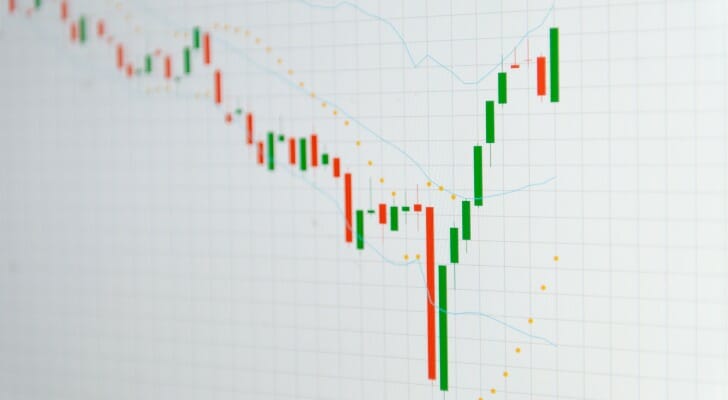When researching stocks, there are two approaches you can use: fundamental analysis and technical analysis. The former focuses on the financial health of a company while the latter focuses on how the company’s shares are trading. Bollinger Bands are one tool used in technical analysis to study and understand stock movements. Developed by technical trader John Bollinger, they can be used to evaluate stock volatility and pricing shifts. If you’ve considered using technical analysis to build a portfolio, it helps to know how and when to use Bollinger Bands and what they can tell you about a stock.
A financial advisor can help you understand which type of technical analysis is most relevant to your portfolio.
Bollinger Bands, Explained
A Bollinger Band is essentially an analytical tool that allows investors to get a price snapshot of a particular stock. These bands consist of three parts: a middle band, upper band and lower band. These bands work together to identify pricing trends.
The middle band represents a moving average, which measures stock price changes over a set time period. The upper band and lower band are set at standard deviations above and below the moving average, respectively. This is designed to account for volatility which can affect a stock’s price movements over time.
Upper and lower bands can expand or contract as volatility increases or decreases. For example, if there’s more volatility surrounding a stock’s price, then the bands expand. But contraction can occur if volatility dies down. The idea behind Bollinger Bands is to get a sense of whether a stock’s price is high or low, relative to the market, and how much volatility is playing a part in impacting prices. This can help with making decisions about whether to buy or sell a particular stock and when it makes sense to do so.
How Bollinger Bands Work

As mentioned, Bollinger Bands rely on a moving average, which typically tracks 20 time periods. What measurement is used for a period depends on the investor and their preferences. For example, the moving average can track 20 days or be broken up into 20 10-minute increments for a single day of trading. The upper and lower bands are usually set two standard deviations above and below the selected moving average, but this is customizable as well.
To use a Bollinger Band to analyze stock pricing, you would first have to calculate a 20-day moving average. If you’re using a 20-day period, for example, you would average up the closing prices for the 20-day period beginning with your chosen starting point. From there, you would calculate the standard deviation for the upper and lower bands. Once you have those numbers, you can plot Bollinger Bands onto a graph or chart.
Doing so allows you to see volatility as it happens with a particular share’s pricing. Again, if the bands get wider at any point on the graph, that means volatility has increased. And if the bands are narrower, then volatility has decreased.
What Bollinger Bands Tell Investors
Bollinger Bands can be useful for tracking trends in price movements, relative to the amount of volatility the market is experiencing. For instance, you can use them to gauge how likely a stock’s price trend is to continue in the near- or long-term, based on whether the movement is up or down. They can also be helpful for determining when a period of low volatility may be followed by a period of increased volatility or vice versa.
In terms of limitations, the biggest has to do with how data is weighed inside the moving average. Specifically, older price data is weighted the same as newer price data which may distort trends when plotting the bands on a graph.
How to Use Bollinger Bands for Technical Analysis

A Bollinger Band is just one technical analytical tool you can use when deciding whether to buy or sell a specific stock. They’re intended to be used alongside other technical indicators, rather than relied on solely for making trading decisions. With that in mind, there are some important things to know about how to interpret the data generated by Bollinger Bands. This means knowing how to spot certain patterns as you analyze the charts.
For example, when the bands draw close together to the moving average, that can signal a squeeze. A squeeze means volatility is low overall and it may be an appropriate time to make a trade. Bollinger Bands can also track breakout movements when a stock’s price increases or decreases significantly.
But it’s important to remember that the bands aren’t necessarily a definitive tool in making decisions about your investment portfolio. For example, just because a share price touches an upper band or lower band doesn’t mean that it’s the right time to buy or sell. It’s not uncommon for share prices to repeatedly do so when the market is experiencing an ongoing upturn or downturn. Rather than buying or selling when these touches happen, you may want to look for other signals the bands can throw off.
For example, something called a double bottom can happen when a stock’s price falls, rises, falls again and then rises. The key is what happens when share prices fall. If the second fall is close to the previous price drop, then that could suggest the stock is preparing to increase in value. Following that logic, it could be the right time to buy before the share price begins to skyrocket.
You may also see scenarios where a stock’s price seems to slope within the upper band range. For example, the price may move above the upper band, then touch the band, then dip below it. This kind of pricing trend could suggest that a stock’s price momentum is beginning to lose steam and you may want to reconsider your position in it.
Bottom Line
Using Bollinger Bands can be a helpful tool, among many others, for doing technical analysis of shares. Just remember to consider other indicators as well. By looking at things like trading volumes, moving averages and relative strength index you can get a more well-rounded picture of how a stock’s price activity is trending and where it may be headed next.
Tips for Investing
- Consider talking to a financial advisor about the benefits of using a technical analysis approach and how to interpret Bollinger Bands. SmartAsset’s free tool matches you with up to three vetted financial advisors who serve your area, and you can interview your advisor matches at no cost to decide which one is right for you. If you’re ready to find an advisor who can help you achieve your financial goals, get started now.
- Whether you’re considering getting started with investing or you’re already a seasoned investor, an investment calculator can help you figure out how to meet your goals. It can show you how your initial investment, frequency of contributions and risk tolerance can all affect how your money grows.
Photo credit: ©iStock.com/KanchitDon, ©iStock.com/Julia_Albul, ©iStock.com/coffeekai
